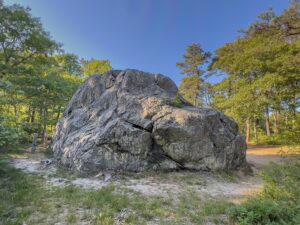EASTHAM — For at least the last couple of hundred years, the boulder near Coast Guard Beach known as Doane Rock has been a popular spot for rock climbers and rock sitters. So, word spread quickly when, for seven days in May, a sign in front of the rock announced: “Notice Do Not Climb on Doane Rock.”

Linzy French, a visual information specialist at the Cape Cod National Seashore, told the Independent on June 3 that the sign that went up on May 20 was the result of a mistake. The Seashore covered the errant message on May 27, and French said it will remove the sign entirely soon.
Still, the outcry over the sign was loud. A photo of the sign posted in an Eastham social media group accrued more than 200 comments, nearly all of them denouncing the sign. People took selfies climbing the rock in defiance. One person placed an American flag on top of the rock. Someone edited the sign to read “Please Do Climb on Doane Rock.” Lines of Yusuf Islam’s 1970 song appeared on it: “Will you tell us when to live?/ Will you tell us when to die?/ Tell me where do the children play?”
French told the Independent by email that the sign was part of a larger Cape Cod National Seashore sign project “with over a thousand signs scheduled to be replaced or installed.” The problem was that the project was conceived in 2015. Back then, French said, Doane Rock was deemed a safety risk because granite was flaking from it. At the time, the Park erected a fence around the area and added a “no climbing” sign to its future plans.
In the intervening nine years, the sloughing of the granite appears to have slowed and is now limited to the back side of the rock, which remains blocked off by a small fence, while the rest of the rock is free to be climbed. This change, however, appears not to have been picked up by those working on the sign project.
French confirmed that the sign “does not reflect a Park regulation or rule.” She did write, however, that vandalizing the sign is still illegal.
A Local Tradition
Doane Rock arrived at its spot near modern-day Coast Guard Beach around the end of the last Ice Age, when a slowly melting glacier shrank northward and dropped all the sand, dirt, and rocks that it carried along the way. Its current name came millennia later; it is named for early Eastham colonist John Doane. It’s the largest known glacially deposited rock — known as a “glacial erratic” — on Cape Cod.
Doane Rock reaches about 18 feet above ground and likely around 12 feet below the surface. Its sloping east-facing surface is the side that invites climbing.
During the week in which it seemed no climbing was allowed at Doane Rock, there was an outpouring of grief for a lost local tradition. A hike followed by a picnic atop the rock was a family ritual for many growing up in town.
Suzie Norgeot Schwebach, who grew up in Orleans and moved to Eastham in the 1990s, said that climbing Doane Rock is a highlight of her grandkids’ visit every summer. “Whenever they come down, the first thing they want to do is go to Doane Rock,” which is located about 1,500 feet down the road from Schwebach’s house.

Her grandson James is particularly fond of the rock, she said. From the time he was about 18 months old, Schwebach said, James would occasionally announce, “I’m going to Doane Rock.” If the family ever lost track of him, he could likely be found ambling down the road on his way there.
For many people, climbing Doane Rock has served as a coming-of-age milestone. “Climbing on it is such a satisfying primal experience for little kids,” wrote Susan Hoadley, whose family has owned a house in Eastham since 1967. “Half a century later I still remember how exhilarating it can be.” When her own kids were finally allowed to climb it, “it felt like a big childhood Rubicon had been crossed.”



